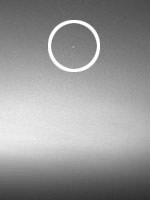
Image credit: NASA/JPL
Consistently highly rated among those memorable ‘money-shots’ from the current Mars’ surface exploration is a view looking back towards the Earth. On Thursday, the Spirit rover team released the banner image showing the Earth as a tiny gray dot in the martian sky near the horizon.
The history of such views backwards towards the home planet, Terra Firma, have captivated the imagination for a generation of astronomers. This glimpse from the surface of another planet offers an unrivalled perspective that stretches beyond just seeing our home as one of many planets, or the only pale blue dot in our solar system.
As Carl Sagan’s widow, Anne Druyan , described this perspective image to Astrobiology Magazine, such earth views make “us look at this tiny planet, at the pale blue dot, and to see it in its real context, in its actual circumstances, in its true tininess. I don’t know anyone who’s able to really see that one-pixel Earth and not feel like they want to protect the Earth; that we have much more in common with each other than we’re likely to have with anyone anywhere else.”
The evocative phrase describing the Earth as a ‘pale blue dot’ was coined by Carl Sagan after seeing our planet as a single pixel. The view was taken from the departing Voyager spacecraft. The entire earth could be encompassed as a flicker of light. The first image of Earth ever taken from another planet that actually shows our home as a planetary disk was captured by the Mars Orbital Camera on May 8th.
One question that might be answerable from such a world-view is could a scientist on Mars identify from such a perspective that the Earth harbored life. In 1993, a team of researchers inspired by Carl Sagan, used an Earth fly-by of the Galileo spacecraft on its way to Jupiter to catch a glimpse of how the Earth might appear from afar. For astrobiologists, Sagan’s results were surprising.
Rather than seeing the Earth as an obvious candidate for life, the Galileo pictures gave surprisingly few clues of the biological potential of our own planet.
From afar, how Galileo missed the obvious signs of terrestrial life as we would have expected to see them, was at first disconcerting to the scientific community, because future missions aim to observe more distant extrasolar planets and detect what would be visible in the spectra–the ‘pale blue dot’ scenario.
One answer may lie in the fact that the spacecraft made its observations while still quite close to the Earth.
“The spectrograph was designed to look at small areas of Jupiter, so the field of view of the spectrograph was quite small,” said Nick Woolf of Arizona, in earlier discussions with the Astrobiology Magazine.
“Also, since the surface brightness of Jupiter [the Gaileo’s intended visual target] is far less than the Earth, the spectrograph detectors saturated except when the spectrograph was pointed at the darkest area of Earth – a cloud-free section of sea,” Woolf noted. The cloud-free sea is considered very dark relative to the dominance of bright clouds in a global picture of Earth. Thus it should come as no surprise that Galileo was successful in only imaging a relatively dark and lifeless planet, mainly because its design was not intended to look at Earth, but to probe Jupiter instead.
A spectroscope that might detect infrared or visible light looking back on Earth or outwards to other planets might focus mainly on four gases that are found in Earth’s atmosphere and linked to life:
* Water vapor A baseline sign, indicating the presence of liquid water, a requirement of known life.
* Carbon dioxide Can be created by biological and non-biological processes. Because it is necessary for photosynthesis, it would indicate the possible presence of green plants.
* Methane Considered suggestive of life, it also can be made both by biological and non-biological processes.
* Molecular oxygen (O2) – or its proxy, ozone (O3). The most reliable indicator of the presence of life, but still not conclusive.
Unless molecular oxygen in the atmosphere is constantly replenished by photosynthesis, it is quickly consumed in chemical reactions, in the atmosphere, on land and in seawater. So the presence of a large amount of oxygen in an extrasolar planet’s atmosphere would be a sign that it might host an ecosystem like present-day Earth’s.
An additional oxygen-related biosignature is the possibility of detecting green plants that make oxygen. Chlorophyll reflects near-infrared light very strongly, a phenomenon known as the “red edge” because the light is just beyond the range of colors human eyes can see. (If humans could see the red edge, plants would look red instead of green.) Near-infrared cameras would have no trouble picking up this distinctive signal.
Not only are earth-views aesthetically interesting, while offering a chance to test remote sensing scenarios, the rovers more practically depend on a daily sky view to navigate. The rover design does not possess any intrinsic way of knowing its orientation as north or south for instance, because Mars doesn’t offer a strong magnetic field that might typically give a compass reading. So scientists point the rover’s mobile panoramic camera to do a sun sighting daily, which also provides today’s orientation. Navigating by stars on Mars is also possible although the rovers’ solar power arrays typically are put into electronic sleep-modes at night to conserve power.
Spirit imaged stars on March 11, 2004, after it awoke during the martian night for a communication session with NASA’s Mars Global Surveyor orbiter. This image is an eight-second exposure. Longer exposures were also taken. The images tested the capabilities of the rover for night-sky observations. Scientists will use the results to aid planning for possible future astronomical observations from Mars.
Original Source: NASA Astrobiology Magazine
